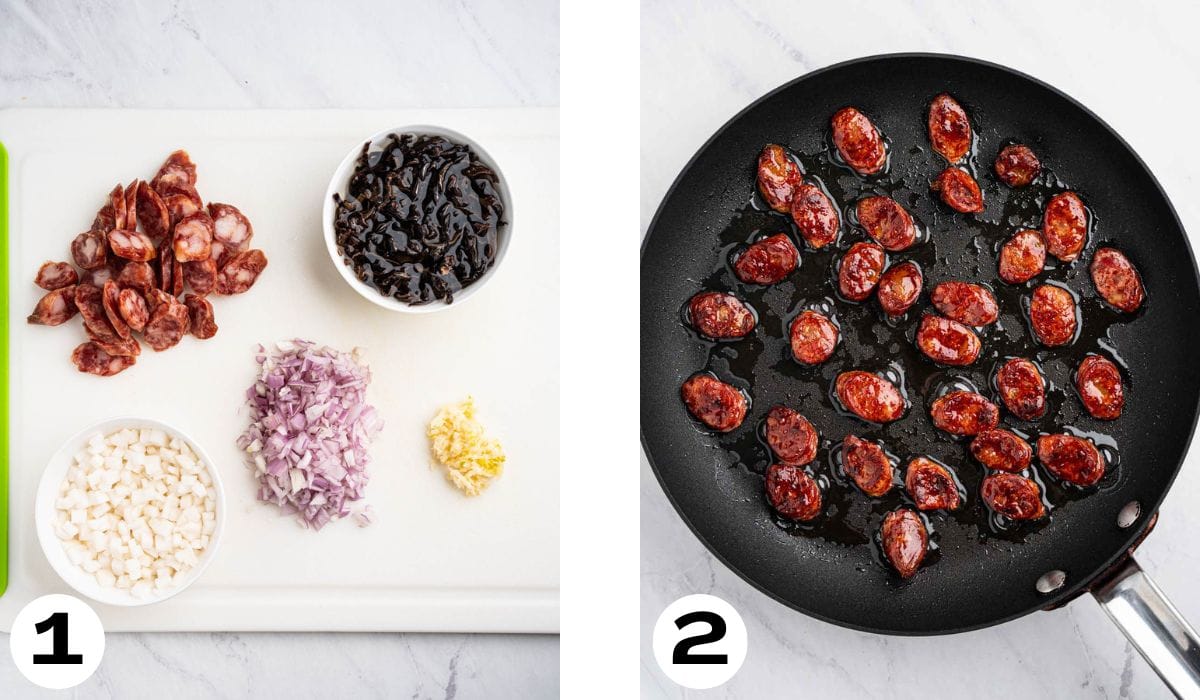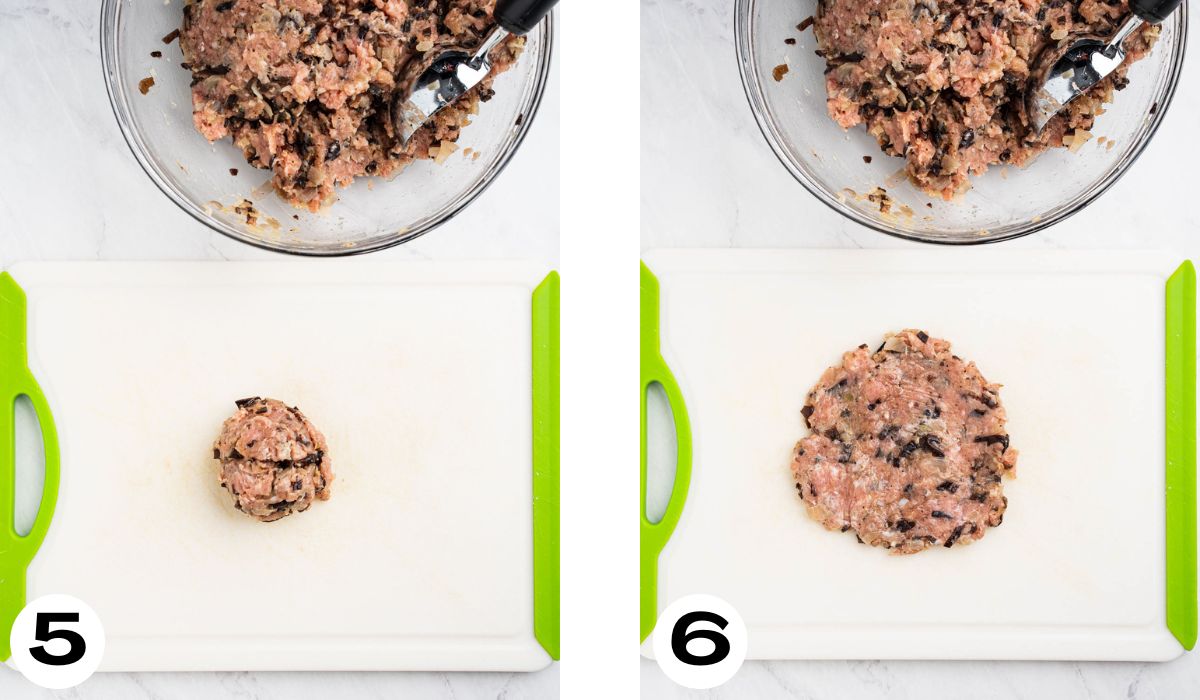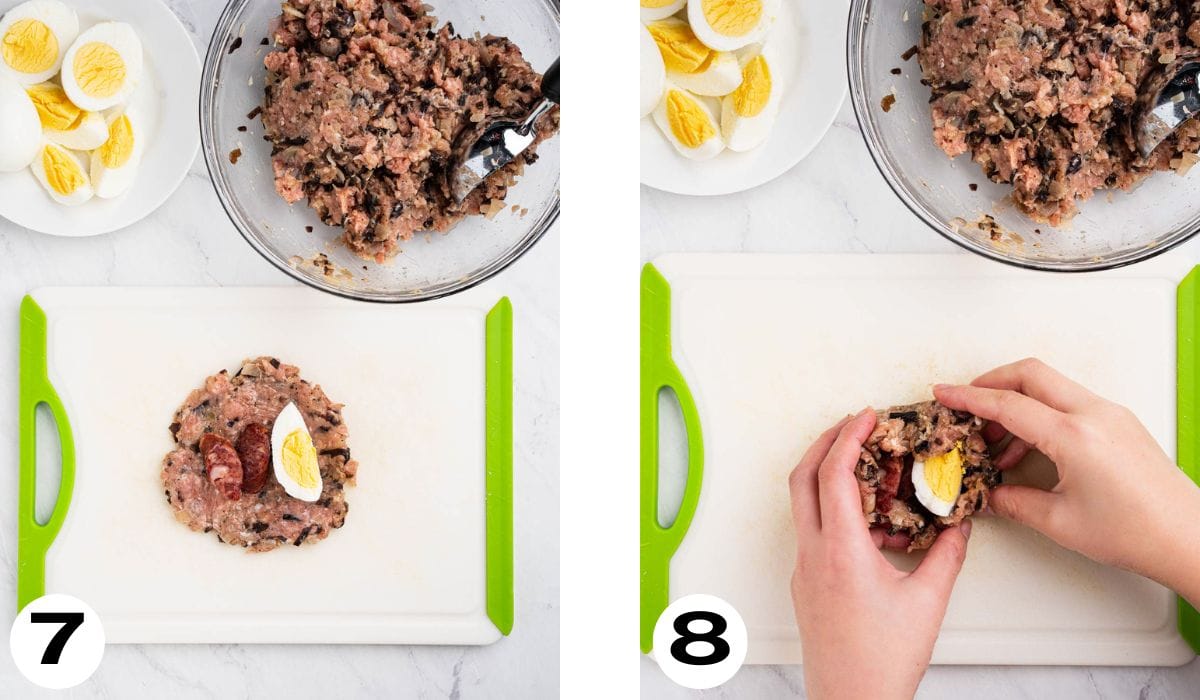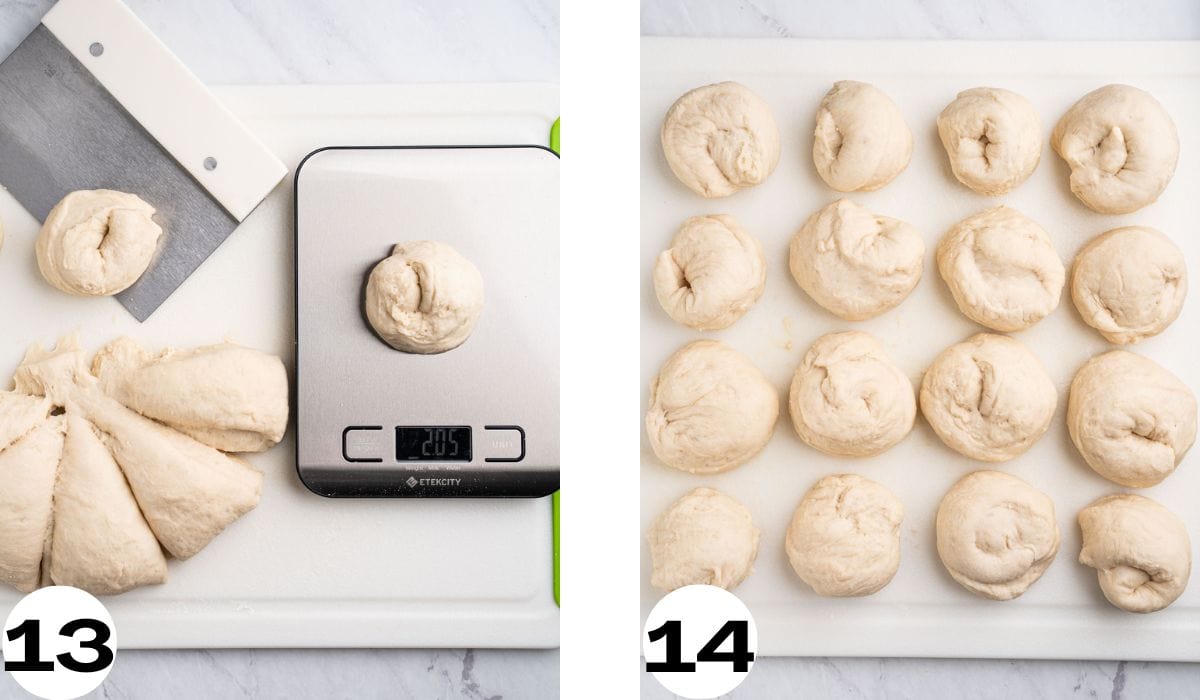Bánh Bao (Vietnamese Steamed Pork Buns)
Banh Bao, popularly known as Vietnamese Pork Buns, are steamed buns filled with a savory mixture of seasoned ground pork, mushrooms, aromatic vegetables, and spices. In Vietnam, these are a breakfast treat! These soft and fluffy buns promise an explosion of flavors, making them a must-try comforting meal to start the day.

The best part about whipping up these baos at home is that you’re the boss of your buns. You can jazz them up by tossing in some Chinese sausages and a perfectly hard-boiled egg – my personal favorite twist. Your buns, your rules! So, get creative, add those extras you love, and make these Vietnamese steamed pork buns your very own delicious masterpiece.
These steamed buns can easily transition from a morning treat to a satisfying snack or even a hearty dinner option. Whether you’re craving a flavorful bite during lunch or looking for a unique dish to serve at dinner, banh bao fits the bill.
What is Bánh Bao?
Banh Bao is a Vietnamese steamed bun with a soft, fluffy exterior made from a yeast-based dough. These pillowy buns are typically filled with a savory mixture, often including seasoned pork, mushrooms, and sometimes hard-boiled quail eggs, creating a delicious blend of flavors and textures. In addition to savory variations, there are sweet versions filled with ingredients like custard or sweetened mung bean paste.
The buns are meticulously folded and pleated, then steamed until they achieve a delicate and airy consistency. Banh Bao is a popular snack or breakfast item in Vietnam. Soft, pillowy dough hugging the most flavorful fillings. It’s like a little bit of heaven in every bite!

What Makes a Great Steamed Pork Bun?
- Pillowy Softness: The best banh bao strikes a balance between the slightly sweet, tender exterior and the fluffy, airy interior, achieved through meticulous dough preparation and proper steaming.
- Balanced Filling: A blend of flavors and textures. The filling should be well-balanced and generously proportioned.
- Visual Appeal: The pleats and folds of the steamed bun should showcase craftsmanship. A glossy, perfectly steamed surface is the hallmark of a banh bao prepared with care and attention to detail.
Gather These Kitchen Tools
- Measuring cups and spoons
- Mixing bowl
- Cutting board and knife
- Stand mixer
- Rolling pin
- Bamboo or metal steamer
Ingredients You’ll Need…
For the Bao Dough:

- All Purpose Flour and Cornstarch: All-purpose flour gives structure and strength to the dough, while cornstarch contributes tenderness and a softer crumb. The combination helps achieve a balance between a soft, fluffy texture and a slightly chewy consistency. The addition of cornstarch can help lighten the color of the bao buns, giving them a whiter appearance.
- Salt: Used to enhance the sugar and season the filling.
- Baking Powder: A leavening agent to help the banh bao rise.
- Instant Yeast (Quick Rise or Rapid Rise Yeast): 1 packet equals 2 1/4 teaspoons. Used to leaven the dough by fermenting sugars, producing carbon dioxide gas, which creates bubbles and causes the dough to rise, resulting in a light and airy texture in the finished product.
- Warm Milk: Used with yeast in baking to activate and accelerate the yeast’s fermentation process. Ensure that the milk is between 115-125°F by heating it in the microwave for 30 seconds, followed by 15-second intervals until warm.
- Sugar: Used to help the yeast grow and to add sweetness to the buns.
- Vegetable Oil: Contributes to the softness and tenderness of the dough and helps make the dough more pliable and easier to work with during the preparation and shaping of the buns
- Vinegar (for steaming): Adding a small amount of vinegar to the steaming water can help preserve the whiteness of the bao buns.
For the Filling:

- Hard-Boiled Eggs or Quail Eggs and Chinese Sausages (Lap Xuong)
- Shallot and Garlic: Use 2-3 shallots or half an onion. Cook them slightly and let them cool before adding them to the meat filling. Sweating the veggies allows them to release their natural sugars, which caramelize and develop a sweeter, richer flavor. It also avoids a strong, raw crunch.
- Jicama: For a crunchy texture, leave it out or substitute it with water chestnuts or even pear.
- Wood Ear (or Shiitake) Mushrooms: For a chewy texture, soak the wood ear mushrooms as directed on the package and chop them before adding them to the meat filling. You can also substitute them with shiitake mushrooms or leave them out altogether.
- Sugar, Salt, Chicken Bouillon Powder, and Ground Pepper: Used to season the filling. Adjust to your taste.
- Oyster Sauce: This gives the filling a sweet and savory flavor. You can also use an oyster sauce substitute such as mushroom oyster sauce or soy sauce and some brown sugar.
- Sesame Oil: Used to impart a distinctive nutty and aromatic flavor
- Ground Pork: For a meaty filling. There are many different versions, but pork is more traditional. You can also substitute with ground chicken and ground beef. For a vegetarian option, substitute it with tofu (or vegan ground meat), mushrooms, and vegetables.
- Cornstarch: Used for moisture control and helps bind the ingredients together. It absorbs excess moisture in the filling, preventing it from becoming overly wet or making the bun soggy during steaming.
Please scroll ⬇️ to the recipe card to see the full ingredient amounts and instructions.
Let’s Make Some Banh Bao!
Make the Filling

- In a hot skillet over medium-high heat, sauté the Chinese sausages without oil for 2 minutes on each side. Then, transfer the sausages to another plate and set it aside.

- To the same skillet, use a paper towel to wipe off the excess oil and add shallots, garlic, jicama, mushrooms, and salt. Sweat the vegetables for 3-4 minutes until translucent. Set this aside and let it cool completely.
- In a large bowl, combine ground pork, sugar, chicken bouillon powder, ground pepper, oyster sauce, sesame oil, and cornstarch.
- Once the vegetables are cooled, combine them with the ground pork mixture. Gently mix until well incorporated (but do not overmix.)


- Scoop 1 1/2 tablespoons of the meat mixture and flatten it into a pancake shape. Add the egg and 2-3 slices of Chinese sausage into the middle and fold the meat around it into the shape of a ball. This will yield around 12-14 meatballs. Cover and refrigerate.
Make the Bao Dough

- Attach a dough hook to the stand mixer. In the stand mixer bowl, combine all-purpose flour, cornstarch, sugar, yeast, salt, baking powder, and warm milk.
- Start with the lowest speed for 1 minute until the ingredients are combined. Increase the speed to 3 and let it knead for 10 minutes until all the ingredients are blended. Add vegetable oil halfway through. The dough should be smooth, elastic, soft, pliable, and slightly sticky. (If it is too sticky, you may need to add more flour and knead some more.) Cover and let it rest for 15 minutes.
Interrupted while baking or want to plan ahead? Cover your dough loosely and refrigerate. Come back within 24 hours, remove from the fridge, and resume rising.

- Lightly dust your hands and work surface. Then, knead the dough by hand for 1 minute, and form a ball. Divide it into 12-14 uniform pieces (about 2 oz each). Roll them into balls, cover them, and let them rest for an additional 15 minutes. (Pro tip: It’s important to keep the dough covered when it is not in use to prevent it from drying out.)

Assemble the Banh Bao

- Use a roller to flatten the dough, leaving it slightly thicker in the middle with flattened edges. Place a meatball in the middle and create small pleats to wrap it. Repeat until all the meat and dough is used up.

- Cover and let the dough proof for 30 minutes.
Steam the Buns

- In a steamer, add water and 1 tablespoon of vinegar. Bring to a boil. Arrange the buns in the steamer, leaving about an inch in between each. You may need to work in batches depending on the size of the steamer.
- Steam for 18 minutes. Then, turn off the heat, leaving the lid on, and let it sit for 3 minutes. (Pro tip: Quickly exposing the banh bao to air will cause them to deflate.)
Serve warm. Enjoy!

Helpful Tips
– Use a kitchen scale for precise measurement of the dough ingredients (especially the flour) and dividing the dough portions. Achieve a soft and pliable dough by carefully measuring ingredients. Consistency is key for the desired pillowy texture.
– If you don’t have a kitchen scale, use the spoon and sweep method to measure the flour. Spoon it into the measuring cup and level it off with a straight edge for accuracy. Avoid packing the flour, as this can lead to over-measuring and affect the consistency of this recipe.
– Allow the dough adequate time to rise, covering it with a damp kitchen towel or plastic wrap to preserve moisture for a soft, pliable texture. Similarly, when filling the bao, cover any unused dough to prevent drying.
– When preparing the filling, shape it into uniform-sized meatballs to guarantee even cooking for each one. I like to shape all the meatballs first and then set them aside.
– Take your time pleating and folding the bao. I find it easier to hold it in the palm of my hand and turn it as I pleat.
– Add vinegar to water for steaming. The acidity of vinegar activates the baking powder, promoting dough leavening for a softer, fluffier texture. Additionally, it prevents discoloration and elevates the whiteness of the buns.

Troubleshooting
There could be several reasons, such as inactive yeast, insufficient time for the dough to rise, or improper steaming conditions.
It could be from too much liquid in the dough, inaccurate flour measurement, or inadequate kneading. Try adding more flour to the dough mixture (about 1 tablespoon at a time) and knead some more.
Over-kneading the dough, not allowing enough time for rising, or using too much flour.
Place parchment paper or cabbage leaves beneath the buns in the steamer to prevent sticking.
Variations
Vietnamese steamed buns can be filled with various ingredients. While the classic version typically includes pork, mushrooms, and other traditional elements, you can add your own twists to it. Here are some different variations:
- Vegetarian Banh Bao: Filled with a mix of vegetables such as jicama, carrots, tofu, and mushrooms, often seasoned with soy sauce and other flavorful ingredients.
- Seafood Banh Bao: Incorporating seafood like shrimp, crab, or fish as the primary filling. It might include a mix of minced seafood with vegetables and seasonings.
- BBQ Pork Banh Bao (Banh Bao Xa Xiu): This variation features a savory and slightly sweet filling of char siu (Chinese BBQ pork) mixed with onions and other aromatics.
- Curry Chicken Banh Bao: Filled with a flavorful mixture of curry-spiced chicken, potatoes, and carrots, creating a unique and aromatic twist.
- Custard Banh Bao: Filled with a sweet custard, offering a unique and vibrant twist on the traditional sweet bun.
How to Store Leftover Steamed Buns
Allow the steamed buns to cool to room temperature before storing to prevent condensation. Place the cooled Banh Bao in an airtight container or wrap them individually in plastic wrap.
Refrigerate: Store in the refrigerator for up to 2-3 days.
Freeze: For longer storage, Banh Bao can be frozen. Wrap each bun tightly in plastic wrap, place it in a freezer-safe bag, and label it with the date. They can be frozen for up to 1-2 months.
Reheat: To enjoy again, reheat Banh Bao by steaming them for a few minutes until heated through. Alternatively, microwave them for 1-2 minutes with a damp paper towel to maintain moisture.

What to Serve it With
These are quick, handheld breakfasts that you can easily take on the go. They’re a complete meal by themselves, but they pair wonderfully with soy sauce dip or chili garlic sauce like Sriracha for a spicy kick. For some extra veggies, you can eat them with pickled carrots and daikon, a cucumber salad, or garlic stir-fried water spinach rau muong.
RECIPE

Authentic Bánh Bao (Vietnamese Steamed Pork Buns)
Equipment
- Stand Mixer
- Steamer
Ingredients
For the Filling
- 6 hard-boiled eggs, cut in half or quarter or 12 quail eggs, kept whole
- 2 Chinese sausages (Lap Xuong) sliced
- ½ cup shallots chopped
- 2 cloves garlic minced
- ½ cup jicama chopped
- ½ cup wood ear or shiitake mushrooms soaked and chopped
- 1 teaspoon salt
- 1 pound ground pork
- 2 teaspoons sugar
- 1 teaspoon chicken bouillon powder
- ½ teaspoon ground pepper
- 1½ tablespoon oyster sauce
- ½ tablespoon sesame oil
- 1 tablespoon cornstarch
For the Dough
- 4 cups all purpose flour
- 5 tablespoons cornstarch
- ½ cup sugar
- 1 (6oz) packet instant yeast (2¼ teaspoons)
- ½ teaspoon salt
- 1½ teaspoon baking powder
- 1½ cup warm milk
- 2 tablespoons vegetable oil
- 1 tablespoon vinegar (for steaming)
Instructions
Make the filling
- In a hot skillet over medium high heat, sauté the Chinese sausages without oil for 2 minutes on each side. Then, transfer the sausages to another plate and set it aside.
- To the same skillet, use a paper towel to wipe off the excess oil and add shallots, garlic, jicama, mushrooms, and salt. Sweat the vegetables for 3-4 minutes until translucent. Set this aside and let it cool completely.
- In a large bowl, combine ground pork, sugar, chicken bouillon powder, ground pepper, oyster sauce, sesame oil, and cornstarch.
- Once the vegetables are cooled, combine them with the ground pork mixture. Gently mix until well incorporated (but do not overmix.)
- Scoop 1 ½ tablespoons of the meat mixture and flatten it into a pancake shape. Add the egg and 2-3 slices of Chinese sausage into the middle and fold the meat around it into the shape of a ball. This will yield around 12-14 meatballs. Cover and refrigerate.
Make the dough
- Attach a dough hook to the stand mixer. In the stand mixer bowl, combine all-purpose flour, cornstarch, sugar, yeast, salt, baking powder, and warm milk.
- Start with the lowest speed for 1 minute until the ingredients are combined. Increase the speed to 3 and let it knead for 10 minutes, adding oil halfway through. The dough should be smooth, elastic, soft, pliable, and slightly sticky (if the dough is too sticky, you may need to add more flour and knead some more.) Cover and let it rest for 15 minutes.
- Lightly dust your hands and work surface. Then, knead the dough by hand for 1 minute, and form a ball. Divide it into 12-14 uniform pieces (about 2 oz each). Roll them into balls, cover them, and let them rest for an additional 15 minutes. (Pro tip: It's important to keep the dough covered when it is not in use to prevent it from drying out.)
Assemble the Banh Bao
- Use a roller to flatten the dough, leaving it slightly thicker in the middle with flattened edges. Place a meatball in the middle and create small pleats to wrap it. Repeat until all the meat and dough is used up.
- Cover and let the dough proof for 30 minutes.
Steam the buns
- In a steamer, add water and 1 tablespoon of vinegar. Bring to a boil. Arrange the buns in the steamer, leaving about an inch in between each. You may need to work in batches depending on the size of the steamer.
- Steam for 18 minutes. Then, turn off the heat, leaving the lid on, and let it sit for 3 minutes. (Pro tip: Quickly exposing the banh bao to air will cause them to deflate.)
- Serve warm. Enjoy!
Notes
-
- Use a kitchen scale for precise measurement of the dough ingredients (especially the flour) and dividing the dough portions. Achieve a soft and pliable dough by carefully measuring ingredients. Consistency is key for the desired pillowy texture.
-
- If you don’t have a kitchen scale, use the spoon and sweep method to measure the flour. Spoon it into the measuring cup and level it off with a straight edge for accuracy. Avoid packing the flour, as this can lead to over-measuring and affect the consistency of this recipe.
-
- Allow the dough adequate time to rise, covering it with a damp kitchen towel or plastic wrap to preserve moisture for a soft, pliable texture. Similarly, when filling the bao, cover any unused dough to prevent drying.
- Interrupted while making these, or want to plan ahead? Cover your dough loosely and refrigerate. Come back within 24 hours, remove from the fridge, and resume rising.
-
- When preparing the filling, shape it into uniform-sized meatballs to guarantee even cooking for each one. I like to shape all the meatballs first and then set it aside.
-
- Take your time to pleat and fold the bao. I find it easier to hold it in the palm of my hand and turn it as I’m pleating.
-
- Add vinegar to water for steaming. The acidity of vinegar activates the baking powder, promoting dough leavening for a softer, fluffier texture. Additionally, it prevents discoloration and elevates the whiteness of the buns.







